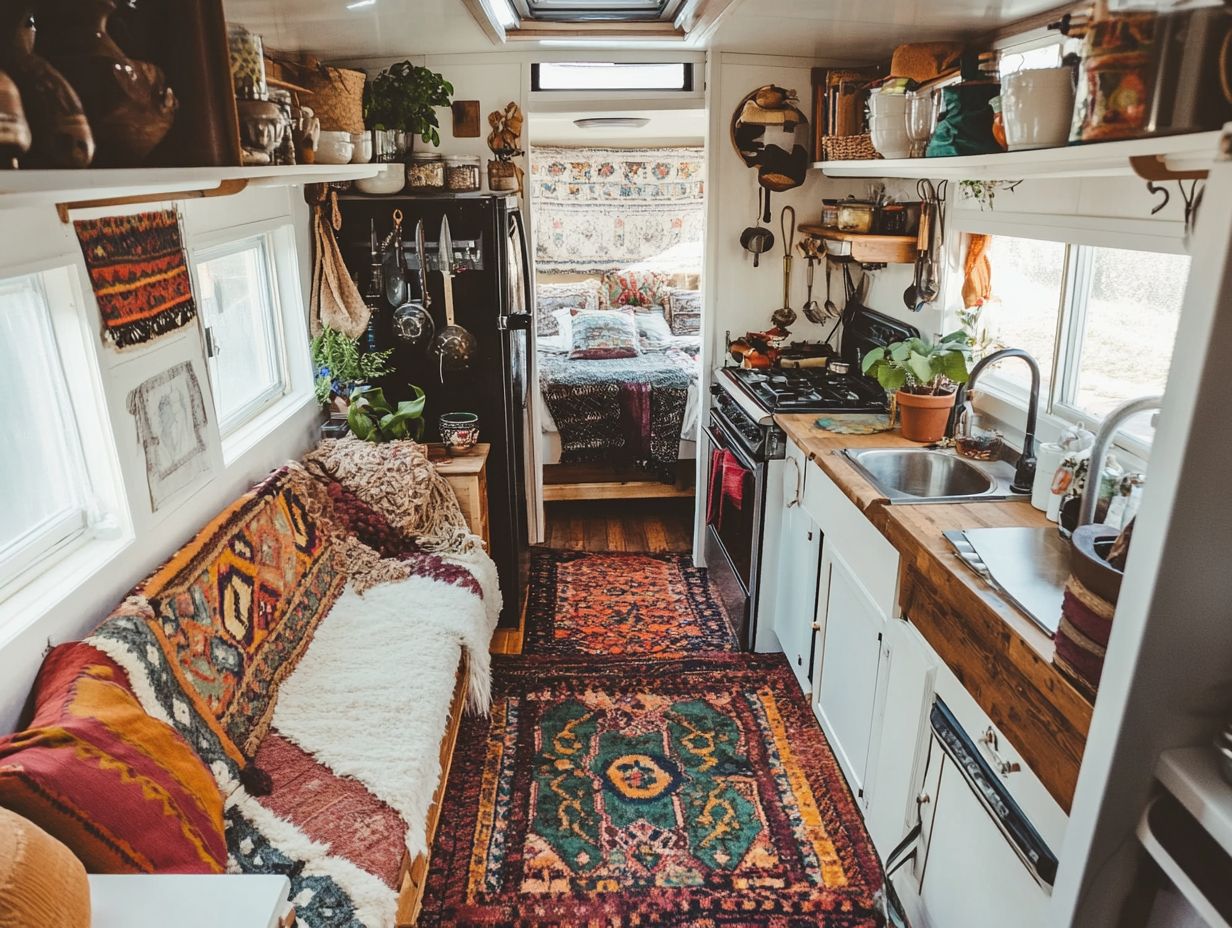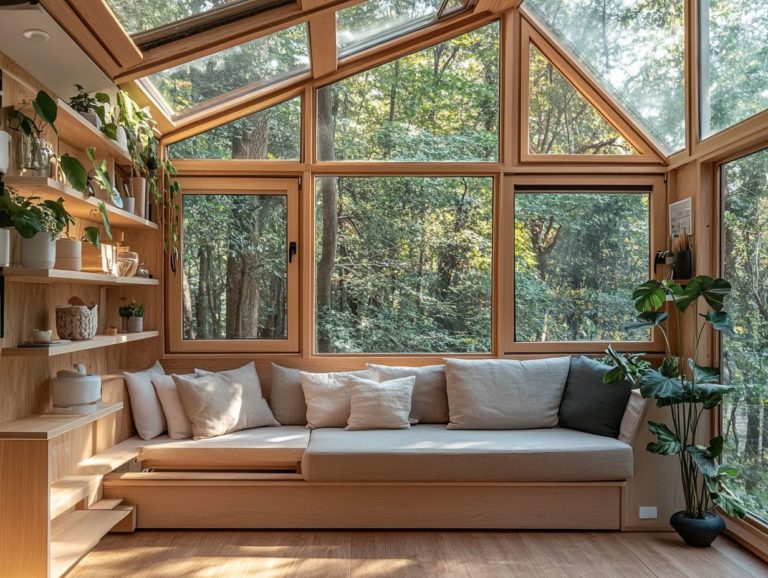How to Use Rugs to Define Spaces in Tiny Homes
In the realm of tiny homes, every square inch matters. Mastering the art of space utilization is crucial.
One effective strategy for creating distinct areas in your cozy living environment is by incorporating rugs. They add warmth and style while visually defining different zones, enhancing the overall functionality of your space.
This article delves into how you can maximize limited space with rugs. We’ll provide design tips, maintenance insights, and alternatives that will elevate your tiny home experience.
Discover how these simple changes can transform your tiny home into a stylish and functional haven!
Contents [hide]
- Key Takeaways:
- The Importance of Space Definition in Tiny Homes
- Using Rugs to Define Different Areas
- Creating a Cohesive Look with Rugs
- Maintaining and Cleaning Rugs in Tiny Homes
- Alternatives to Rugs for Space Definition
- Frequently Asked Questions
- How can I use rugs to define spaces in my tiny home, including creating a workspace design or a reading nook?
- Which rugs work best for creating defined spaces in tiny homes, and how can I integrate jute rugs or wool rugs?
- How do I choose the right size rug for my tiny home while considering the overall color scheme and texture balance?
- Can I use multiple rugs to define a larger space in my tiny home, such as a home gym or a playroom?
- How can I use rugs to define spaces in a studio or open-concept tiny home while maintaining functional zones?
- Do I need to use the same type of rug to define all the spaces in my tiny home, or can I mix rug styles for different functional zones?
Key Takeaways:

- Maximize your limited space in tiny homes by using rugs to define different areas.
- Consider placement and size when choosing rugs for space definition.
- Design tips and tricks can help create a cohesive look with rugs in tiny homes.
The Importance of Space Definition in Tiny Homes
Defining spaces in tiny homes is essential for maximizing limited square footage. By using effective strategies like incorporating area rugs and choosing furniture that does more than one job, you can create distinct functional zones.
This method optimizes open floorplans and fosters a well-organized and visually appealing environment. Never underestimate the significance of these design principles; they are key to achieving a cohesive look while accommodating a range of activities within your small space.
Maximizing Limited Space
Maximizing limited space in your tiny home often requires innovative solutions. For instance, furniture that serves multiple purposes can help save valuable floor area.
These clever pieces optimize your space and add comfort and style, making your small living area feel welcoming. A sofa bed can transform your living room into a guest bedroom, while nesting tables provide adaptable surfaces.
Incorporating area rugs helps delineate distinct zones, adding visual interest and warmth. By strategically organizing your furniture, you can create a functional layout that enhances the aesthetic, ensuring that even the coziest spaces feel spacious and inviting.
Using Rugs to Define Different Areas
Rugs are instrumental in defining distinct areas within a space. This is particularly important in open floorplans or compact settings where establishing functional zones is crucial for maintaining an organized atmosphere.
Types of Rugs for Space Definition
When selecting rugs, consider the various types that enhance both functionality and aesthetics. Jute rugs offer a natural look, while wool rugs provide inviting warmth and comfort.
Each style presents unique benefits, making it easier to create your desired ambiance. For example, geometric patterns can impart a contemporary vibe, while traditional designs often evoke warmth and nostalgia.
Indoor/outdoor rugs offer versatile options. Resistant to moisture and fading, they transition effortlessly from a cozy living room to a sunlit patio, allowing for a cohesive look throughout your home.
Ultimately, choosing the right rug can profoundly influence the character of your space, merging practicality with your personal style.
Placement and Size Considerations

The placement and size of area rugs are crucial in defining spaces and achieving a cohesive look in your tiny home.
In tiny homes, every square foot counts. Choosing the right rug can create distinct areas and enhance both comfort and style. A strategically placed rug anchors your furniture and introduces layers of texture and warmth, which is particularly vital in smaller rooms. Additionally, using space dividers can further optimize your layout and functionality.
When considering size, aim for rugs that either encompass the entire seating area or leave a few inches of flooring visible around the edges. This makes the room feel bigger while maintaining visual harmony. Mixing different rug textures or colors can spark interest, transforming even the coziest spaces into inviting, polished havens.
Creating a Cohesive Look with Rugs
Crafting a cohesive aesthetic in tiny homes is truly an art form. You can elevate this experience through the thoughtful selection and arrangement of area rugs. These rugs not only unify the overall color palette but also harmonize the materials in your space, creating an inviting and stylish atmosphere.
Smart Design Tips for Area Rugs
Incorporating design principles into your use of area rugs can truly elevate both the aesthetic and functional appeal of small spaces. Layering rugs adds depth and combines textures, fostering a cozy atmosphere.
Selecting the right size is essential; a well-sized rug creates a cohesive look, helping to delineate areas and making the space feel more expansive. Consider opting for lighter colors or patterns that reflect natural light, as these can visually open up a room and enhance its overall brightness.
Anchoring your furniture with an area rug not only stabilizes the layout but also cultivates a welcoming ambiance, making the area inviting for both you and your guests.
Maintaining and Cleaning Rugs in Tiny Homes
Keeping your rugs clean in a tiny home is essential for a fresh, inviting space! Given the limited area for storage and upkeep, it becomes even more important to prioritize these tasks.
By doing so, you enhance not only the visual appeal of your home but also contribute to a more inviting and sanitary atmosphere.
Simple and Effective Cleaning Methods
Implementing simple yet effective cleaning methods for your area rugs is essential for maintaining their longevity and visual charm, especially in the confines of small spaces.
Understanding the specific cleaning requirements for various rug materials can streamline your maintenance routine and elevate the overall aesthetic of your home. For example, natural fibers like wool may thrive with periodic professional cleanings, while synthetic options often allow for easier home care through regular vacuuming and spot treatments.
Consistent dusting and immediate attention to spills can significantly extend the beauty of any rug. Whether you own a delicate Persian or a sturdy nylon piece, knowing the best practices ensures that each rug withstands daily wear and remains a stunning focal point in your room.
Storage Solutions for Rugs in Small Spaces

Finding innovative storage solutions for area rugs in small spaces can significantly enhance the organization and functionality of your home environment.
Effective storage ideas can transform how you utilize limited square footage, allowing you to enjoy beautiful area rugs without sacrificing precious space. Consider creative solutions like under-bed storage bins or vertical wall-mounted racks. These clever options tuck away rugs when they re not in use, freeing up floor space and maintaining a tidy atmosphere.
Folding rugs and storing them in a decorative storage box not only preserves their quality but also adds to your overall decor, ensuring every inch of your home remains stylish and organized.
By integrating these strategies, you can blend practicality with aesthetic appeal, creating a space that reflects both beauty and function.
Alternatives to Rugs for Space Definition
While area rugs are a favored option for defining spaces, many other options can effectively delineate areas within your home. Consider using room dividers or multifunctional furniture to create distinct zones that enhance both aesthetics and functionality.
Other Creative Ways to Define Spaces
Creative approaches to defining spaces extend beyond traditional methods. Explore innovative furniture arrangements and the strategic use of room dividers to elevate your interior design.
By reimagining your layouts, you can artfully separate a living area from a workspace. Make the most of furniture like ottomans and shelves that fulfill both aesthetic and practical roles. Embracing design principles such as scale and proportion will empower you to select pieces that create visual harmony and serve the space’s intended purpose.
Textures and colors play a crucial role in this transformation. For instance, a bold carpet can visually delineate an area without the need for physical barriers. Incorporating plants can greatly enhance your space not just as decor, but as natural dividers that foster a sense of tranquility and separation in an open-plan home.
Frequently Asked Questions
How can I use rugs to define spaces in my tiny home, including creating a workspace design or a reading nook?
Transform your tiny home by using rugs to create separate areas. Place a large rug in the living room and a smaller rug in the dining area to designate each space.
Which rugs work best for creating defined spaces in tiny homes, and how can I integrate jute rugs or wool rugs?

Flatweave or low-pile rugs are ideal for defining spaces in tiny homes as they are durable and can be moved or layered easily. These types of rugs are less likely to create tripping hazards in the limited space of a tiny home.
How do I choose the right size rug for my tiny home while considering the overall color scheme and texture balance?
Measure the area you want to define and choose a rug that is slightly smaller to avoid overwhelming the room. A good rule of thumb is to leave at least 6 inches of flooring visible around the edges of the rug.
Can I use multiple rugs to define a larger space in my tiny home, such as a home gym or a playroom?
Yes, you can layer rugs of different sizes and textures to create a cohesive look and define larger spaces in your tiny home. Just ensure the rugs complement each other and maintain a harmonious design.
How can I use rugs to define spaces in a studio or open-concept tiny home while maintaining functional zones?
In a studio or open-concept tiny home, use rugs to create separate areas for living, dining, and sleeping. Placing a large rug under the bed or sofa helps define those areas, while smaller rugs can establish additional zones.
Do I need to use the same type of rug to define all the spaces in my tiny home, or can I mix rug styles for different functional zones?
No, you can mix and match different types of rugs to define various spaces in your tiny home. Ensure they complement each other and fit cohesively within your overall design.
Start rethinking your space today and explore how you can enhance your tiny home with these creative solutions!






